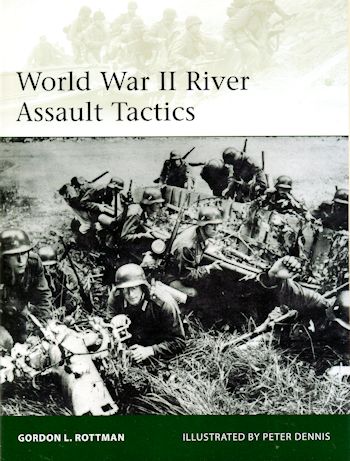 One
thing that many enthusiasts do not consider about land warfare is water. Water
can be a major obstacle for the attacking force and an equally good defensive
medium for the defender. Just look at castles with their moats, for examples.
But there were not a lot of castles to be stormed during WWII and most of the
water that confronted armies were streams and rivers. These could range from
broad expanses of a slow moving major river to deep ravines of streams in the
mountains. They all had to be crossed by the attacking army.
One
thing that many enthusiasts do not consider about land warfare is water. Water
can be a major obstacle for the attacking force and an equally good defensive
medium for the defender. Just look at castles with their moats, for examples.
But there were not a lot of castles to be stormed during WWII and most of the
water that confronted armies were streams and rivers. These could range from
broad expanses of a slow moving major river to deep ravines of streams in the
mountains. They all had to be crossed by the attacking army.
You can be sure that defenders would go out of the
way to make that as difficult as possible. One of the easiest ways to delay the
crossing was by destroying bridges. Another was to be sure to be on the high
ground on the opposite side and place obstructions not only on the far side of
the watercourse, but also on the near side. This could range from sewing mine
fields to cutting down trees and shrubs so there is no cover, to putting up
traps.
All this means that the army had to find alternate
methods of crossing. Boats come to mind, but they are easily targeted by
defenders and even then, it is a slow way to get the rest of the troops across
once the assault is complete. However, this was the preferred method as in most
cases, the water may not be deep enough for larger craft.
Once across, temporary bridges had to be set up and
this includes not only foot bridges but those large enough to carry tanks and
other heavy vehicles. These temporary bridges can be brought with the army or
can be made from local materials if there is time.
Then there is the decision of where to cross. It
has to have relatively shallow approaches so men and equipment don't have to go
down or climb steep banks, the area should be near good roads as being in the
middle of a swamp isn't very useful, and it has to be somewhere that the enemy
has not set up defensive positions. Things are getting complicated. And this all
has to be done everywhere there is a stream or river to get over.
In this book the author first goes into a geography
lesson before getting into the specifics. This starts with improvised means of
crossing then engineer boats, bridge units and bridging equipment. It then
covers the best places to emplace bridges and the defense of these bridges.
Finally, there are sections on how to determine where to cross, how it is
defended and how to conduct an assault.
It is all required reading for those interested in
the tactics and equipment involved in these operations. It will also make
watching 'A Bridge Too Far' much more interesting and understandable. Highly
recommended.
December 2013
For more on the complete line of Osprey books,
visit www.ospreypublishing.com. In the US, it is
Osprey Direct at 443 Park Avenue South, New York, NY 10016, where you can
get a catalogue of available books.
If you would like your product reviewed fairly and
fairly quickly, please contact
the editor or see other details in the Note to
Contributors.
 One
thing that many enthusiasts do not consider about land warfare is water. Water
can be a major obstacle for the attacking force and an equally good defensive
medium for the defender. Just look at castles with their moats, for examples.
But there were not a lot of castles to be stormed during WWII and most of the
water that confronted armies were streams and rivers. These could range from
broad expanses of a slow moving major river to deep ravines of streams in the
mountains. They all had to be crossed by the attacking army.
One
thing that many enthusiasts do not consider about land warfare is water. Water
can be a major obstacle for the attacking force and an equally good defensive
medium for the defender. Just look at castles with their moats, for examples.
But there were not a lot of castles to be stormed during WWII and most of the
water that confronted armies were streams and rivers. These could range from
broad expanses of a slow moving major river to deep ravines of streams in the
mountains. They all had to be crossed by the attacking army.